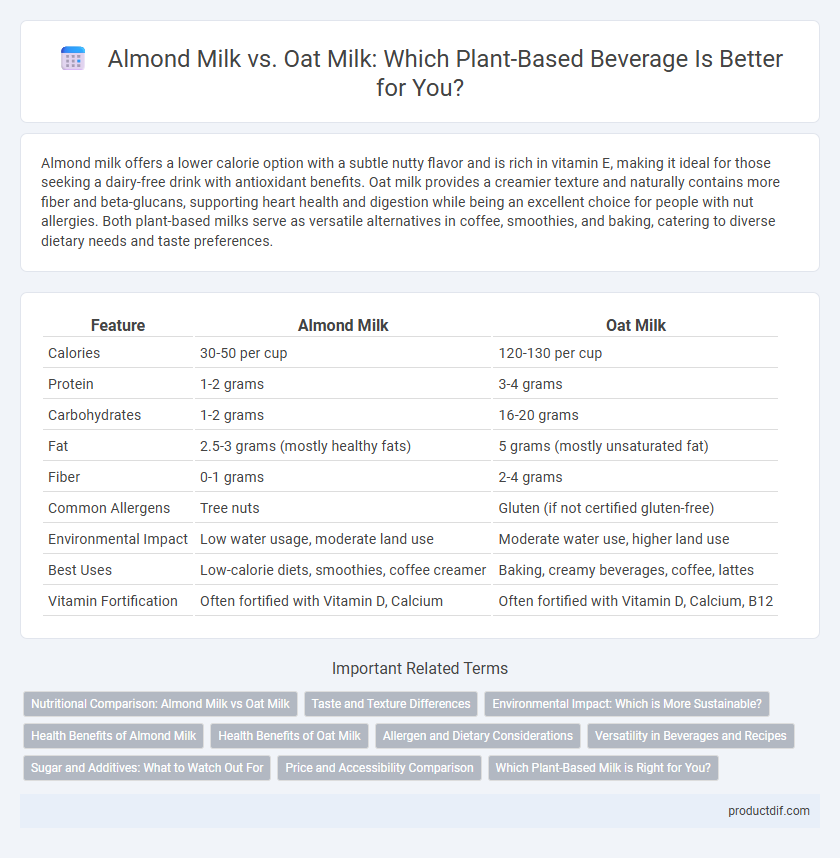Almond milk offers a lower calorie option with a subtle nutty flavor and is rich in vitamin E, making it ideal for those seeking a dairy-free drink with antioxidant benefits. Oat milk provides a creamier texture and naturally contains more fiber and beta-glucans, supporting heart health and digestion while being an excellent choice for people with nut allergies. Both plant-based milks serve as versatile alternatives in coffee, smoothies, and baking, catering to diverse dietary needs and taste preferences.
Table of Comparison
| Feature | Almond Milk | Oat Milk |
|---|---|---|
| Calories | 30-50 per cup | 120-130 per cup |
| Protein | 1-2 grams | 3-4 grams |
| Carbohydrates | 1-2 grams | 16-20 grams |
| Fat | 2.5-3 grams (mostly healthy fats) | 5 grams (mostly unsaturated fat) |
| Fiber | 0-1 grams | 2-4 grams |
| Common Allergens | Tree nuts | Gluten (if not certified gluten-free) |
| Environmental Impact | Low water usage, moderate land use | Moderate water use, higher land use |
| Best Uses | Low-calorie diets, smoothies, coffee creamer | Baking, creamy beverages, coffee, lattes |
| Vitamin Fortification | Often fortified with Vitamin D, Calcium | Often fortified with Vitamin D, Calcium, B12 |
Nutritional Comparison: Almond Milk vs Oat Milk
Almond milk typically contains fewer calories and less sugar than oat milk, making it a low-calorie option ideal for weight management. Oat milk, however, offers higher fiber content and more protein, supporting digestive health and muscle maintenance. Both beverages provide essential vitamins such as vitamin D and calcium, but oat milk's carbohydrate content is significantly higher, benefiting those needing sustained energy.
Taste and Texture Differences
Almond milk offers a light, nutty flavor with a smooth, watery texture that works well in coffee and smoothies. Oat milk features a richer, creamy consistency and a naturally sweet taste that enhances baking and cereal. Consumers often prefer oat milk for its thicker mouthfeel, while almond milk is favored for its refreshing, subtle nutty undertone.
Environmental Impact: Which is More Sustainable?
Almond milk production requires significantly more water, consuming approximately 1.1 gallons of water per almond, compared to oat milk, which uses less water and generates fewer greenhouse gas emissions. Oat milk cultivation often relies on rainwater, reducing the strain on freshwater resources and promoting soil health through crop rotation practices. Overall, oat milk presents a lower environmental footprint, making it a more sustainable choice in terms of water use, carbon emissions, and land impact.
Health Benefits of Almond Milk
Almond milk is rich in vitamin E, a powerful antioxidant that supports skin health and immune function. It is naturally low in calories and contains no cholesterol or saturated fat, making it heart-friendly and ideal for weight management. Almond milk also offers a good source of calcium and vitamin D, essential for bone health and muscle function.
Health Benefits of Oat Milk
Oat milk provides essential nutrients such as beta-glucan fiber, which supports heart health by reducing cholesterol levels. It is naturally rich in vitamins like B12 and D, making it a beneficial option for vegans and those with dietary restrictions. Compared to almond milk, oat milk contains higher protein content and is more environmentally sustainable due to lower water usage.
Allergen and Dietary Considerations
Almond milk is a popular dairy alternative but contains tree nuts, posing allergy risks for individuals with nut sensitivities. Oat milk is naturally free from nuts and soy, making it a safer choice for those with multiple allergies or dietary restrictions such as lactose intolerance and veganism. Both options offer low cholesterol and are typically fortified with vitamins D and calcium to support a balanced diet.
Versatility in Beverages and Recipes
Almond milk and oat milk both offer versatile options for beverages and recipes, with almond milk providing a light, nutty flavor ideal for smoothies, coffee, and baking, while oat milk's creamy texture enhances lattes, soups, and desserts. Almond milk's lower calorie content and subtle taste make it a popular choice for low-fat recipes, whereas oat milk's natural sweetness and richness improve the mouthfeel and consistency in sauces and creamy dishes. Many chefs and home cooks prefer oat milk for its ability to froth well in coffee applications, while almond milk is favored for its compatibility with a variety of flavor profiles in savory and sweet concoctions.
Sugar and Additives: What to Watch Out For
Almond milk often contains added sugars and stabilizers that can impact calorie content and digestion, while oat milk naturally has a higher sugar level due to oat starch conversion but may also include additives like emulsifiers and preservatives. Consumers should check labels for unrefined sweeteners and minimal additives to avoid unwanted health effects. Opting for unsweetened and organic options ensures better control over sugar intake and additive exposure in both almond and oat milk.
Price and Accessibility Comparison
Almond milk typically costs between $2 and $4 per half-gallon, often available in most major grocery stores and online retailers, making it widely accessible. Oat milk, priced similarly around $3 to $5 per half-gallon, has rapidly expanded in availability due to rising consumer demand, appearing in specialty stores, supermarkets, and cafes. Both plant-based milks offer competitive pricing, but oat milk's increasing presence in mainstream outlets enhances its accessibility compared to almond milk in some regions.
Which Plant-Based Milk is Right for You?
Almond milk offers a low-calorie option rich in vitamin E, making it ideal for those seeking a light, nutty flavor with added antioxidants. Oat milk provides a creamier texture and higher fiber content, supporting digestive health while delivering essential nutrients like beta-glucans and B vitamins. Choosing between almond and oat milk depends on dietary needs, such as calorie control or fiber intake, as well as taste preferences and potential allergies.
Almond Milk vs Oat Milk Infographic

 productdif.com
productdif.com